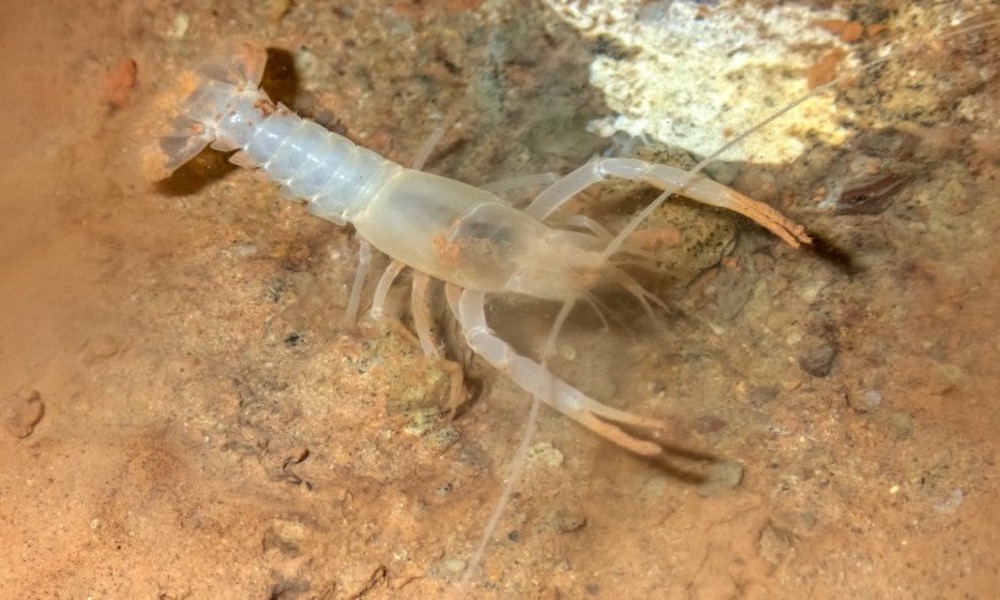The Shelta Cave Crayfish—known scientifically as Orconectes sheltae—was believed to have gone extinct after decades passed without the species being spotted. But that changed when scientists rediscovered the small crayfish in recent years.
The findings were revealed in a paper published May 20 in the journal Subterranean Biology and co-authored by Dr. Matthew L. Niemiller, an assistant professor at the University of Alabama in Huntsville, UAH’s Katherine E. Dooley and K. Denise Kendall Niemiller, and Nathaniel Sturm of the University of Alabama.
The team made excursions into Shelta Cave in 2019 and 2020 and found individuals of the Shelta Cave Crayfish both times.

“The crayfish is only a couple of inches long with diminutive pincers that are called chelae,” Niemiller told UAH. “Interestingly, the crayfish has been known to cave biologists since the early 1960s but was not formally described until 1997 by the late Dr. John Cooper and his wife Martha…
Also on FTW Outdoors: Exotic sea creature washes ashore alive, baffles beachgoer
“To the best of our knowledge, only 115 individuals had been confirmed from 1963 through 1975. Since then, only three have been confirmed – one in 1988 and the two individuals we report in 2019 and 2020.”
More from UAH:
Dr. Cooper, a biologist and speleologist who was a member of the NSS, studied the aquatic life in Shelta Cave with particular focus on crayfish for his dissertation work in the late 1960s and early 1970s. Shelta Cave’s aquatic ecosystem was particularly diverse then, with at least 12 cave-dependent species documented, including three species of cave crayfishes.
“No other cave system to date in the U.S. has more documented cave crayfishes co-occurring with each other,” Dr. Niemiller says.
But the aquatic ecosystem, including the Shelta Cave Crayfish, crashed sometime in the early 1970s. The crash may be related to a gate that was built to keep people out of the cave and yet still allow a grey bat maternity population to move freely in and out.
“The initial design of the gate was not bat friendly, and the bats ultimately vacated the cave system,” Dr. Niemiller says. “Coupled with groundwater pollution and perhaps other stressors, that all may have led to a perfect storm resulting in the collapse of the aquatic cave ecosystem.”
Even before the decline in the aquatic cave community, the Shelta Cave Crayfish was never common compared to the other two species, Southern Cave Crayfish (Orconectes australis) and Alabama Cave Crayfish (Cambarus jonesi)…
“After a couple of decades of no confirmed sightings and the documented dramatic decline of other aquatic cave life at Shelta Cave, it was feared by some, including myself, that the crayfish might now be extinct.”
While it’s encouraging that the Shelta Cave Crayfish still persists, he says scientists still haven’t rediscovered other aquatic species that once lived in the cave system, such as the Alabama Cave Shrimp and Tennessee Cave Salamander.

Niemiller said he didn’t expect to find the Shelta Cave Crayfish since not seeing any while visiting the cave several times before the May 2019 trip. In fact, they were fortunate just to see a couple of Southern Cavefish and Southern Cave Crayfish.
The Shelta Cave, located in Huntsville, Alabama, is a 2,500-foot cave system owned and managed by the National Speleological Society and is beneath the organization’s national headquarters in northwest Huntsville and is surrounded by subdivisions and roadways.
Photos of Dr. Matthew L. Niemiller snorkeling in Shelta Cave and the Shelta Cave Crayfish courtesy of Amata Hinkle and Niemiller.
[listicle id=1905857]
